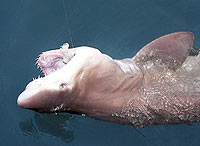Grey Nurse Shark Cool Facts
What’s with the name - Grey Nurse Shark?
The grey part is easy – they are a grey /brown colour on top, although underneath they are white. This counter shading is a common feature of marine animals making them harder to see from above or below when swimming. The nurse part is believed to be due the ability of these sharks to “nurse” or round up schools of fish into compact schools before feeding on them.
What about their scientific name, Carcharias taurus, what is with that?
The genus names of Carcharias is shared amongst many sharks that have large pointed teeth including the Great White and Tiger Sharks. The word carcharo is a Greek word that means sharp pointed, jagged and refers to their teeth. Tauris is a Latin word that means bull refering to their stocky bodies. |


